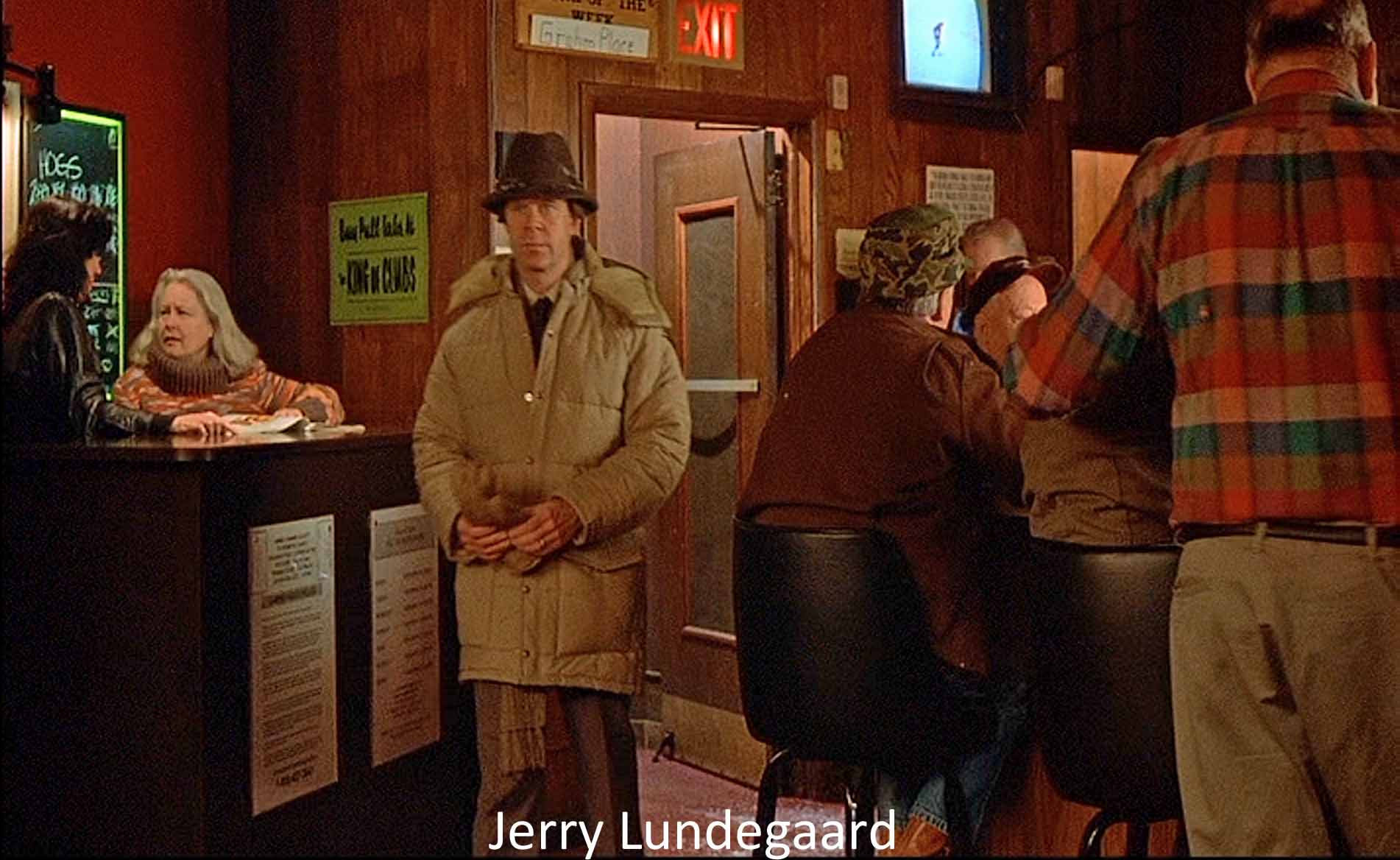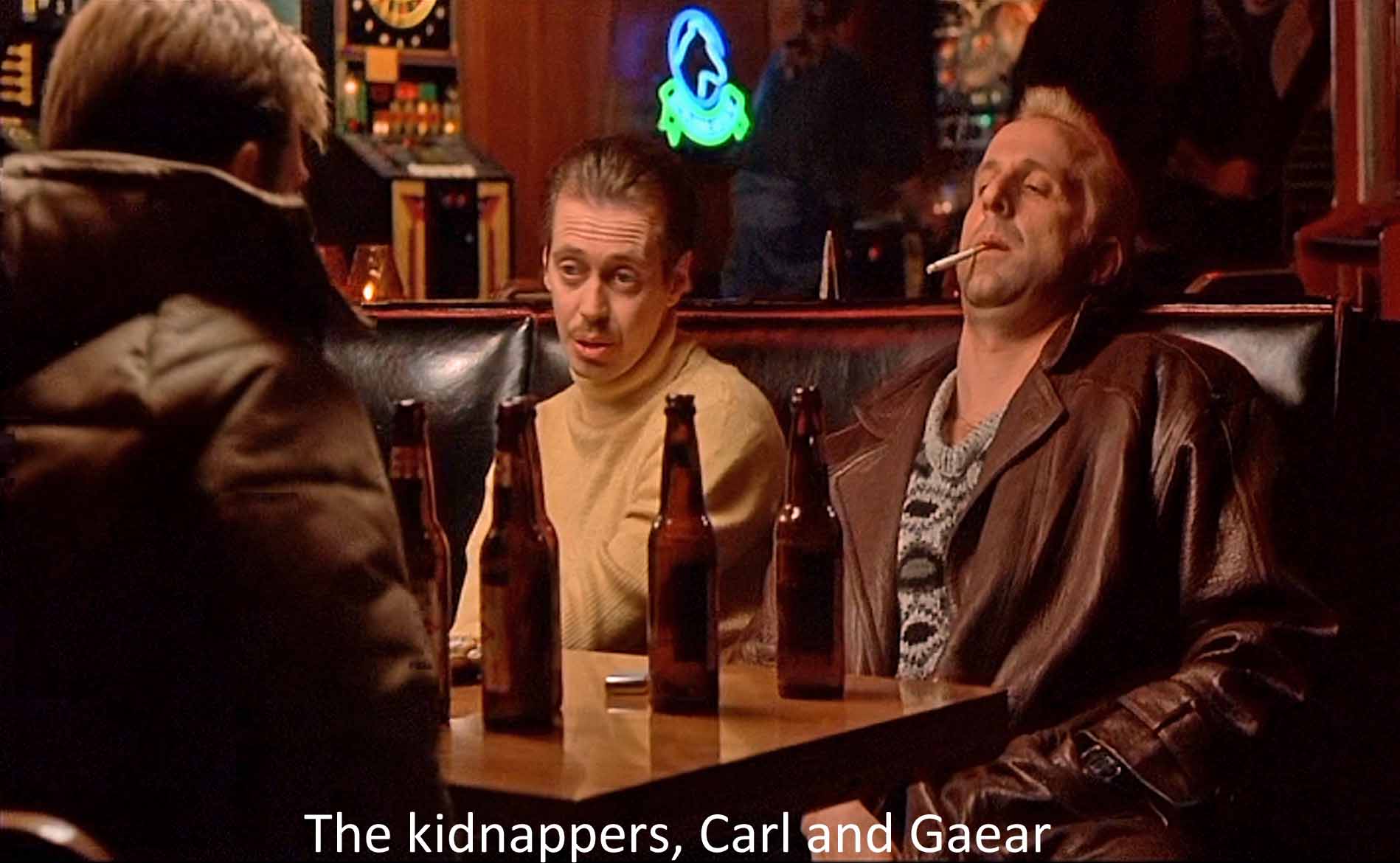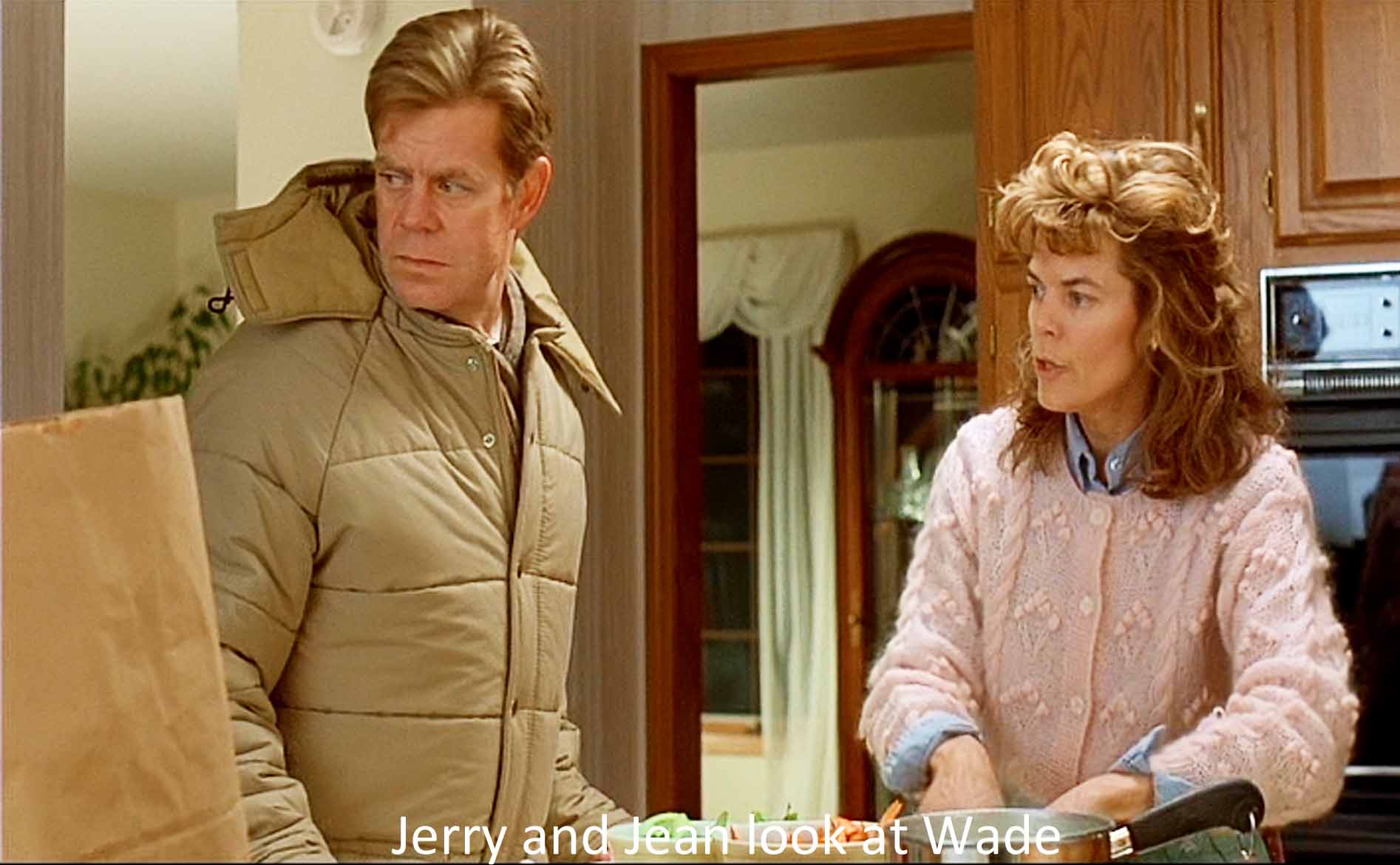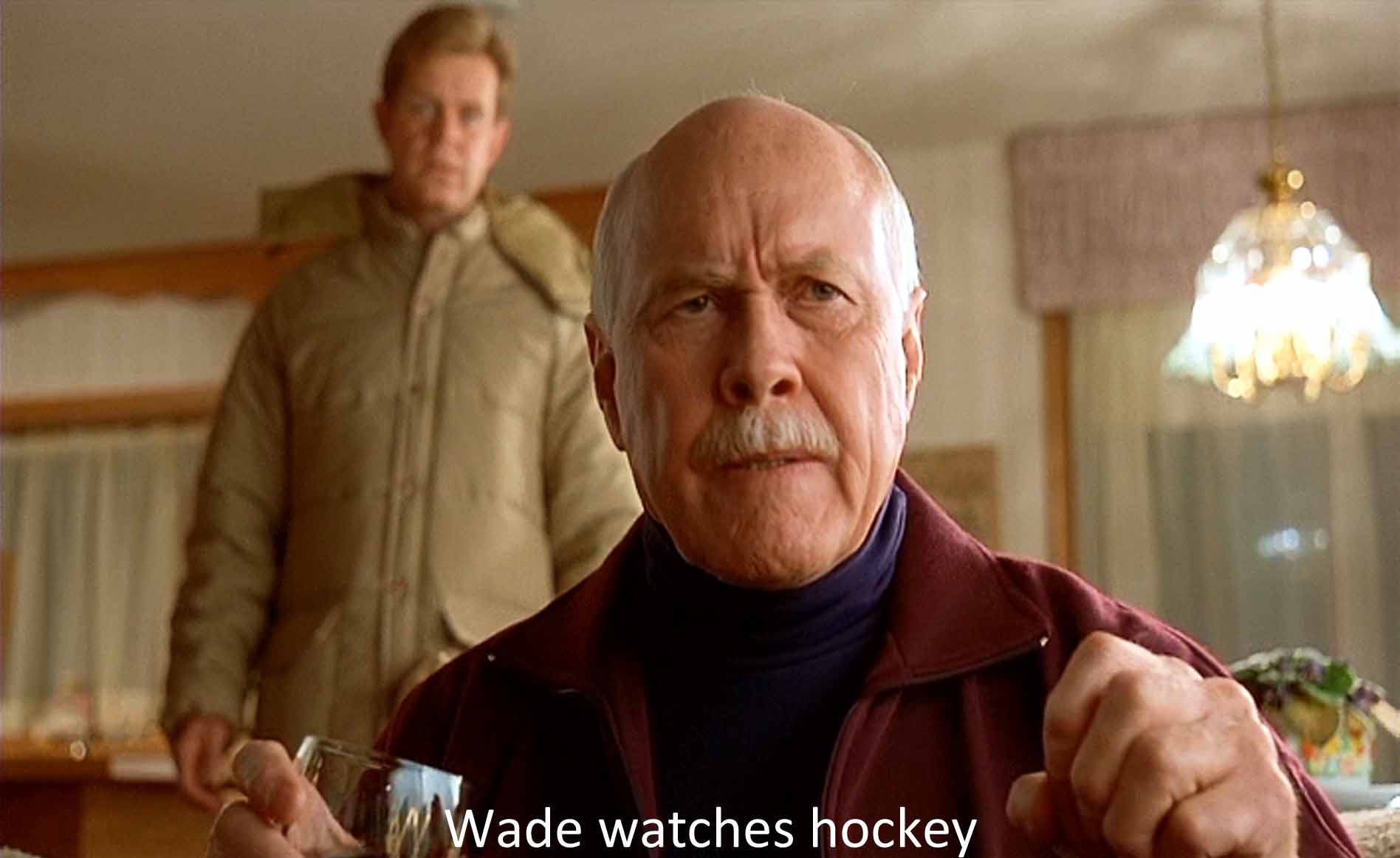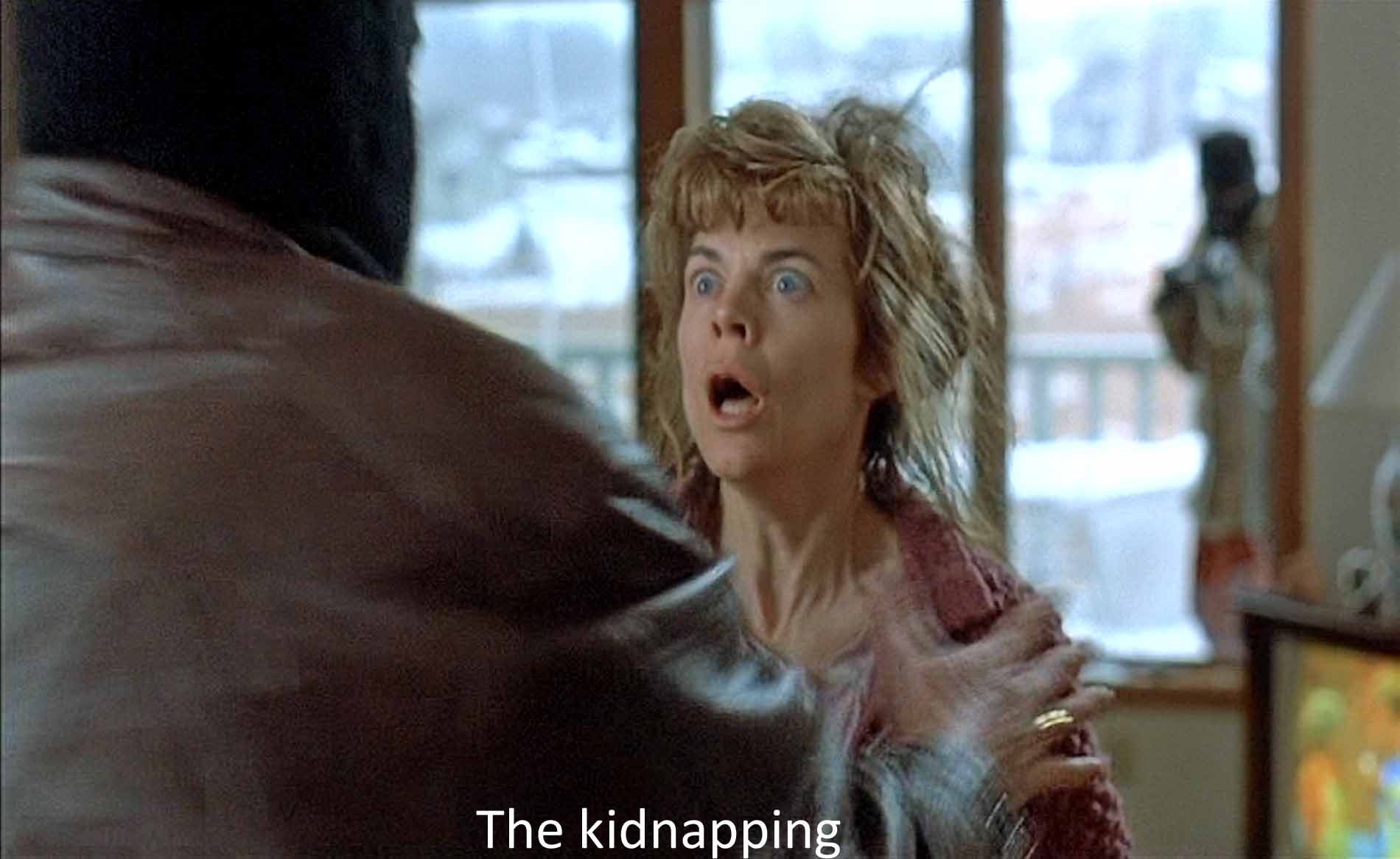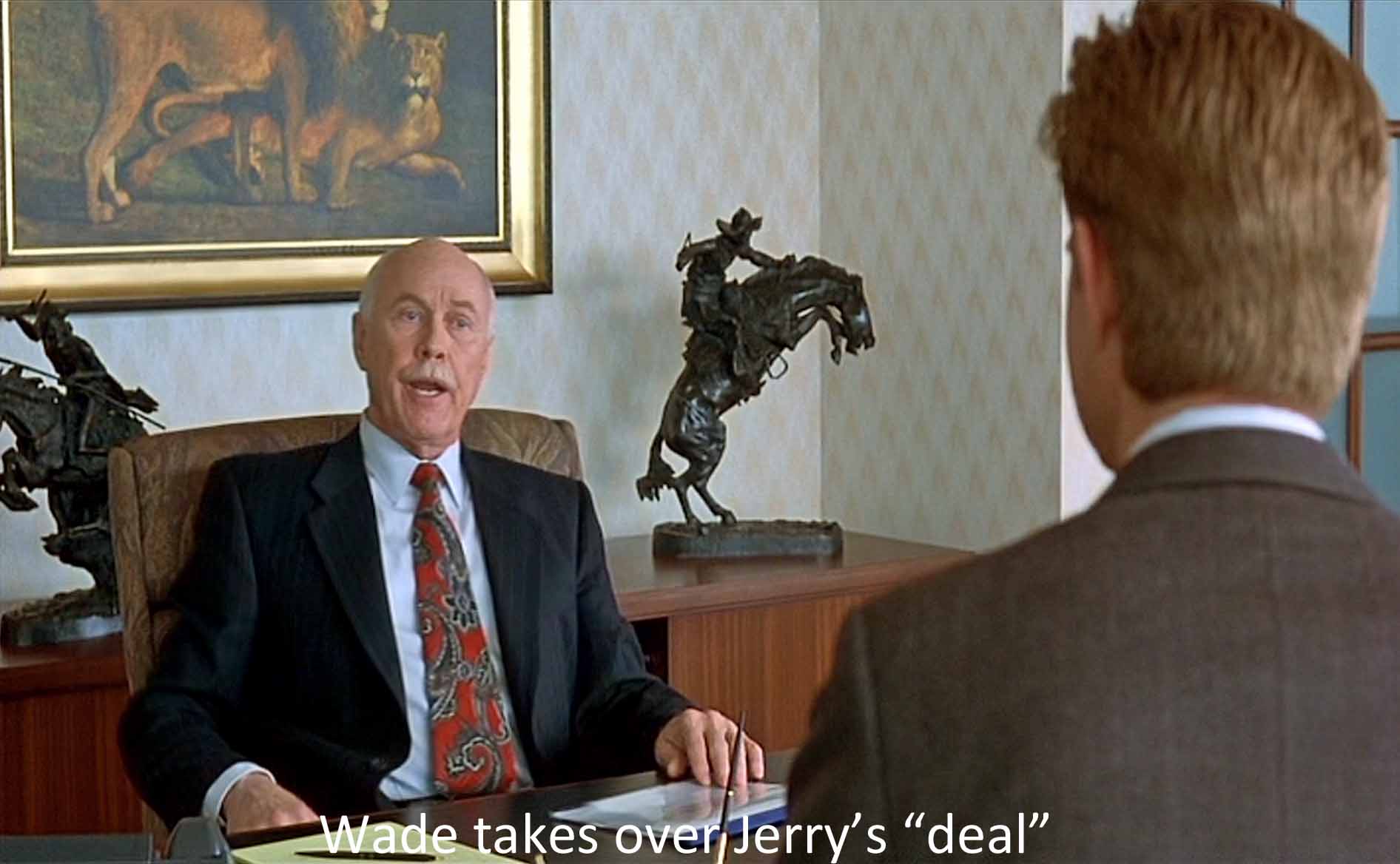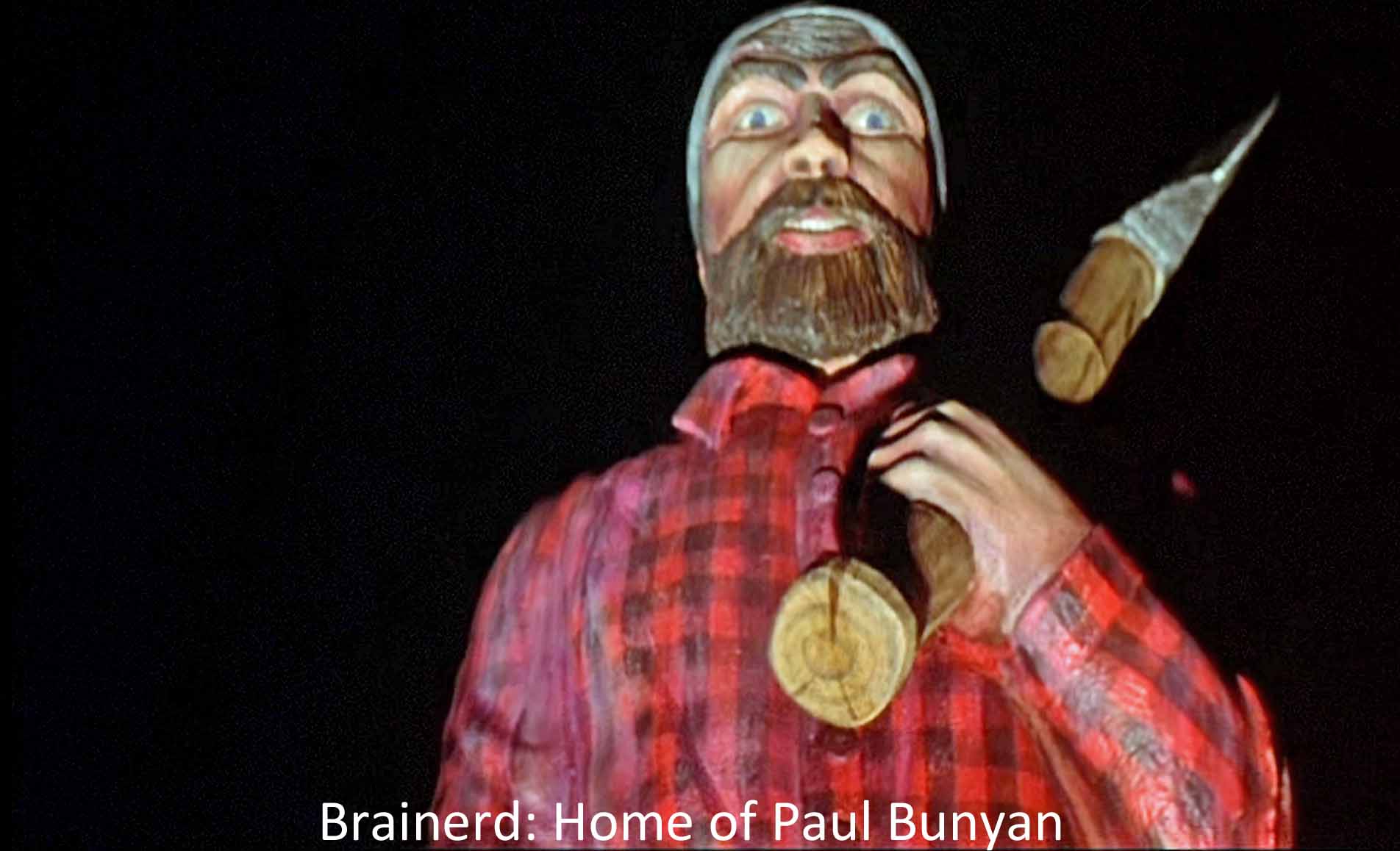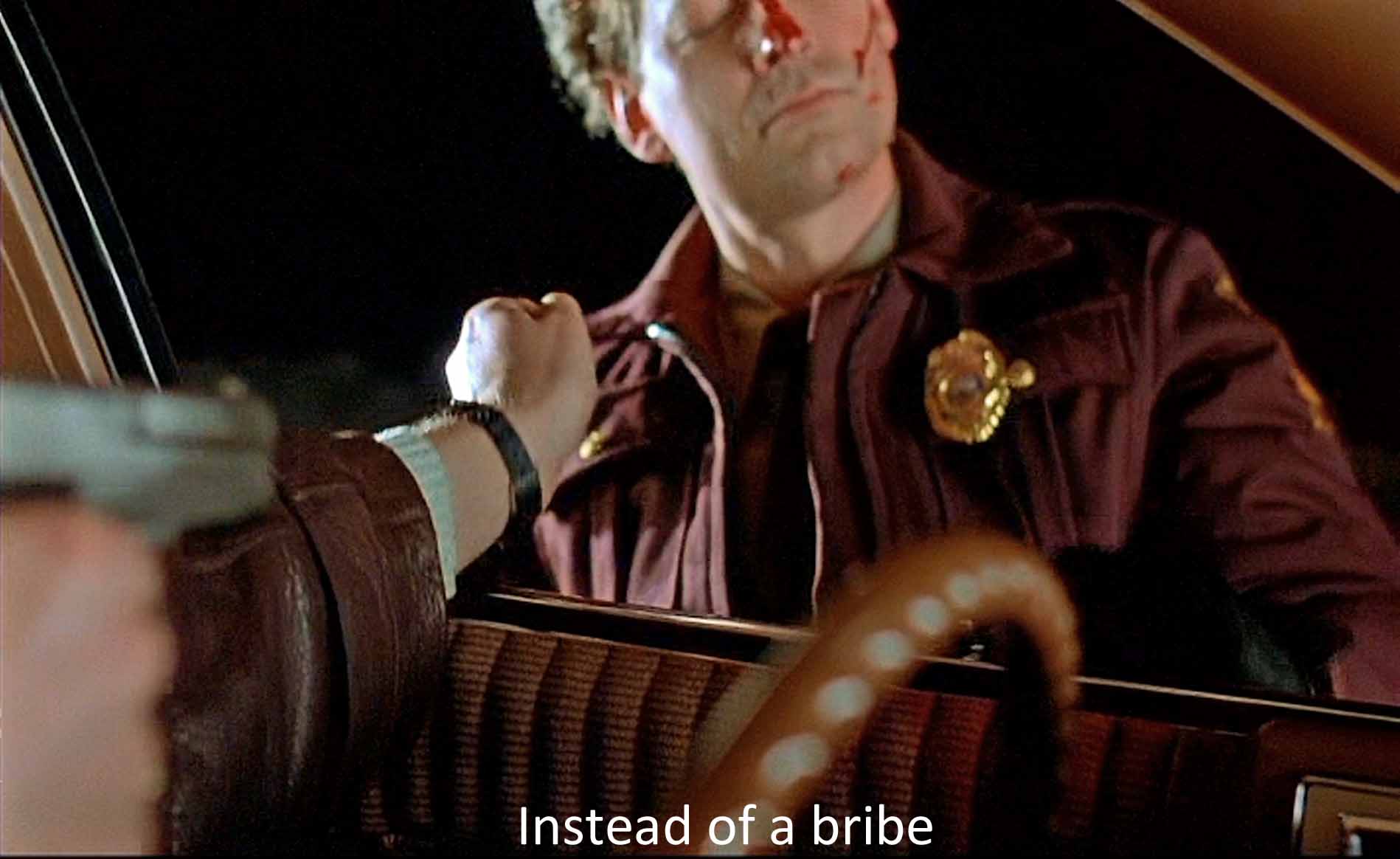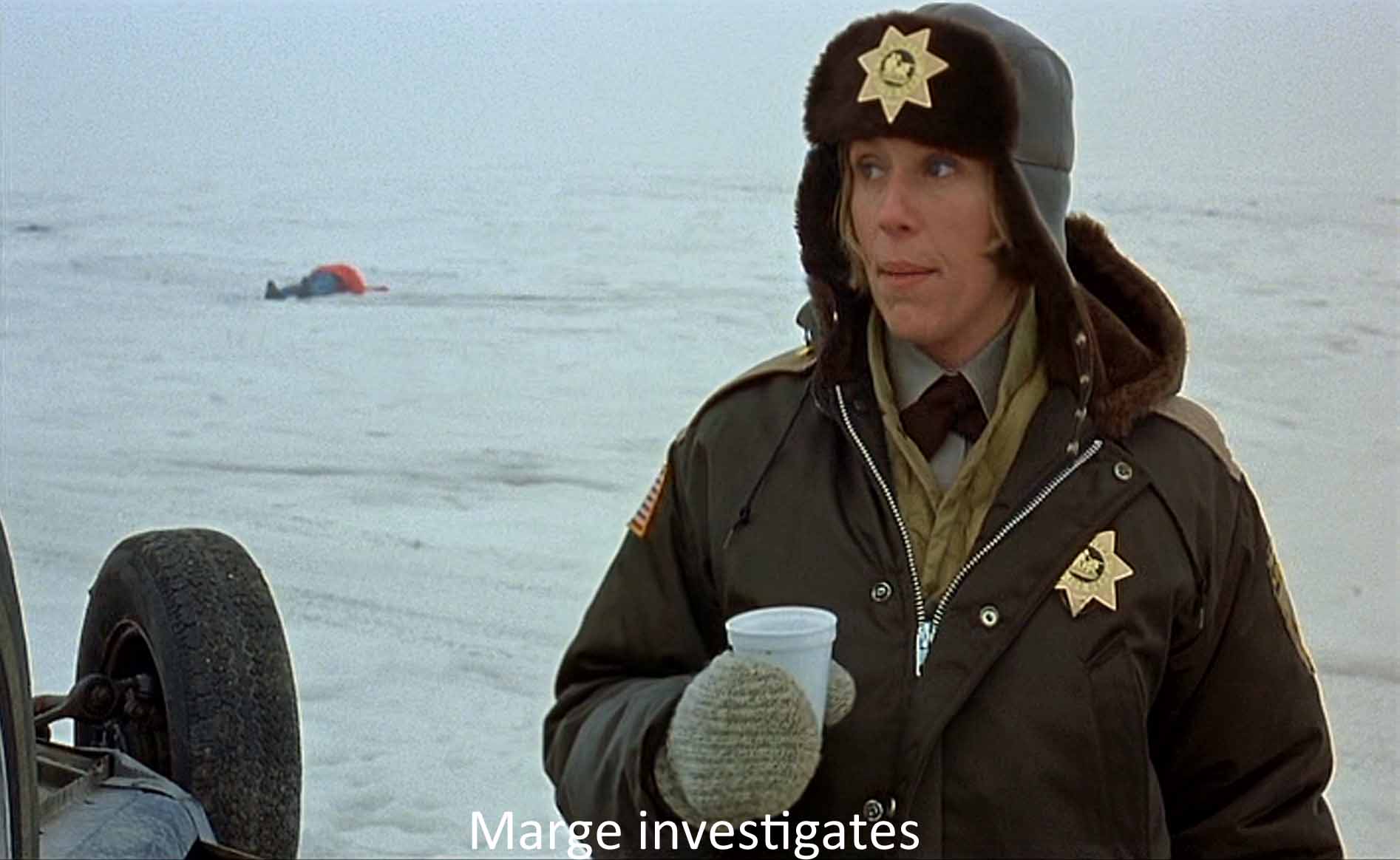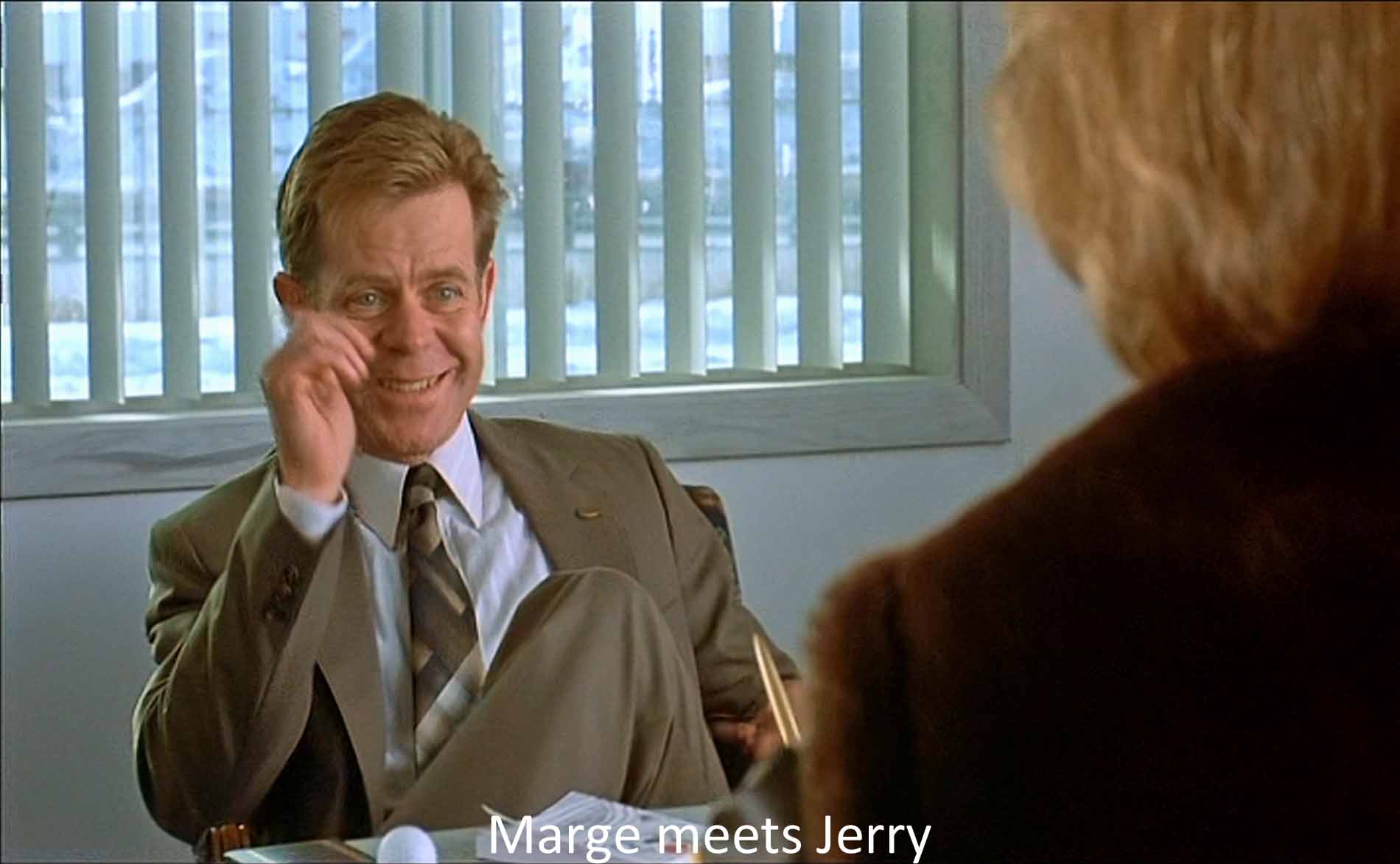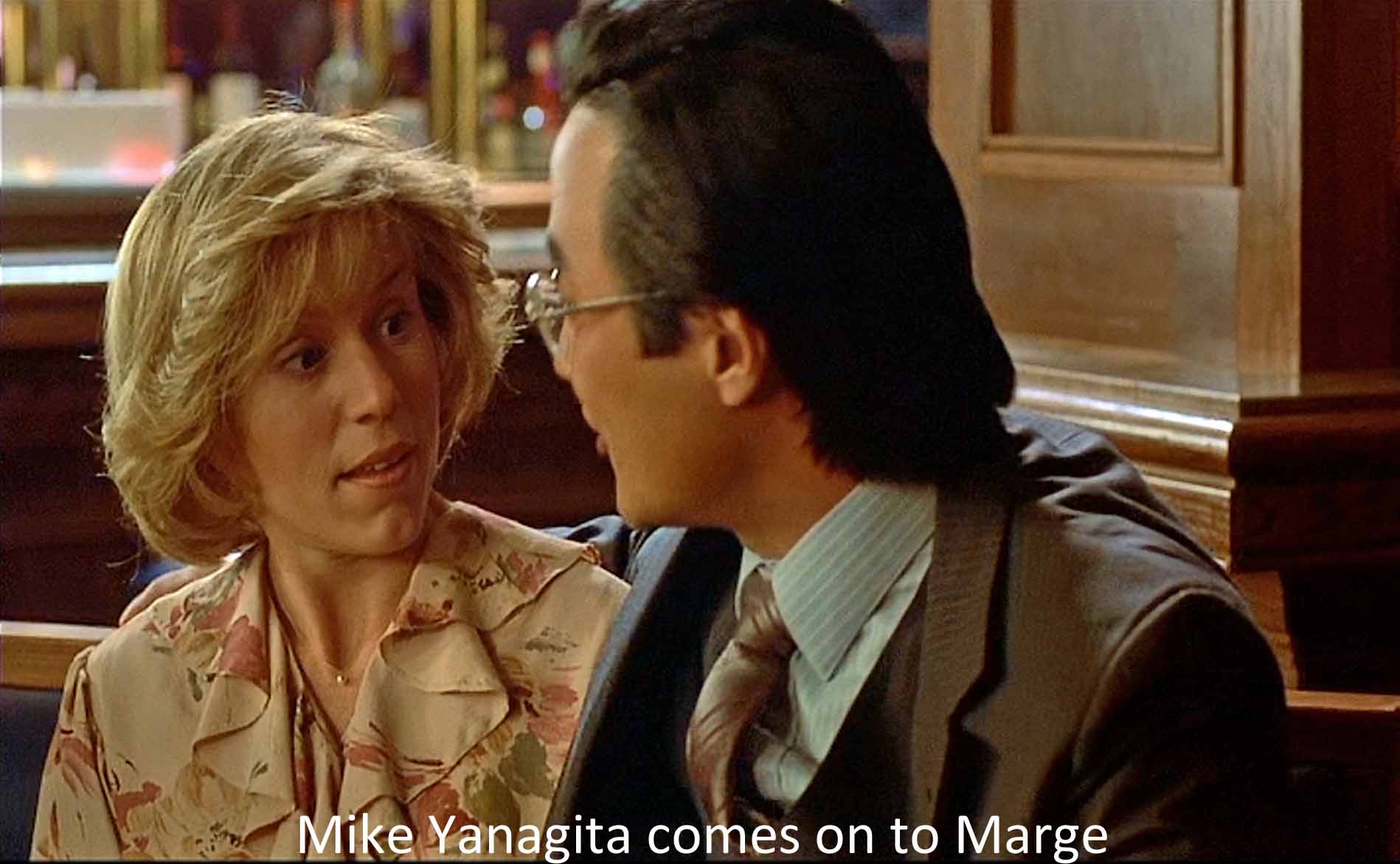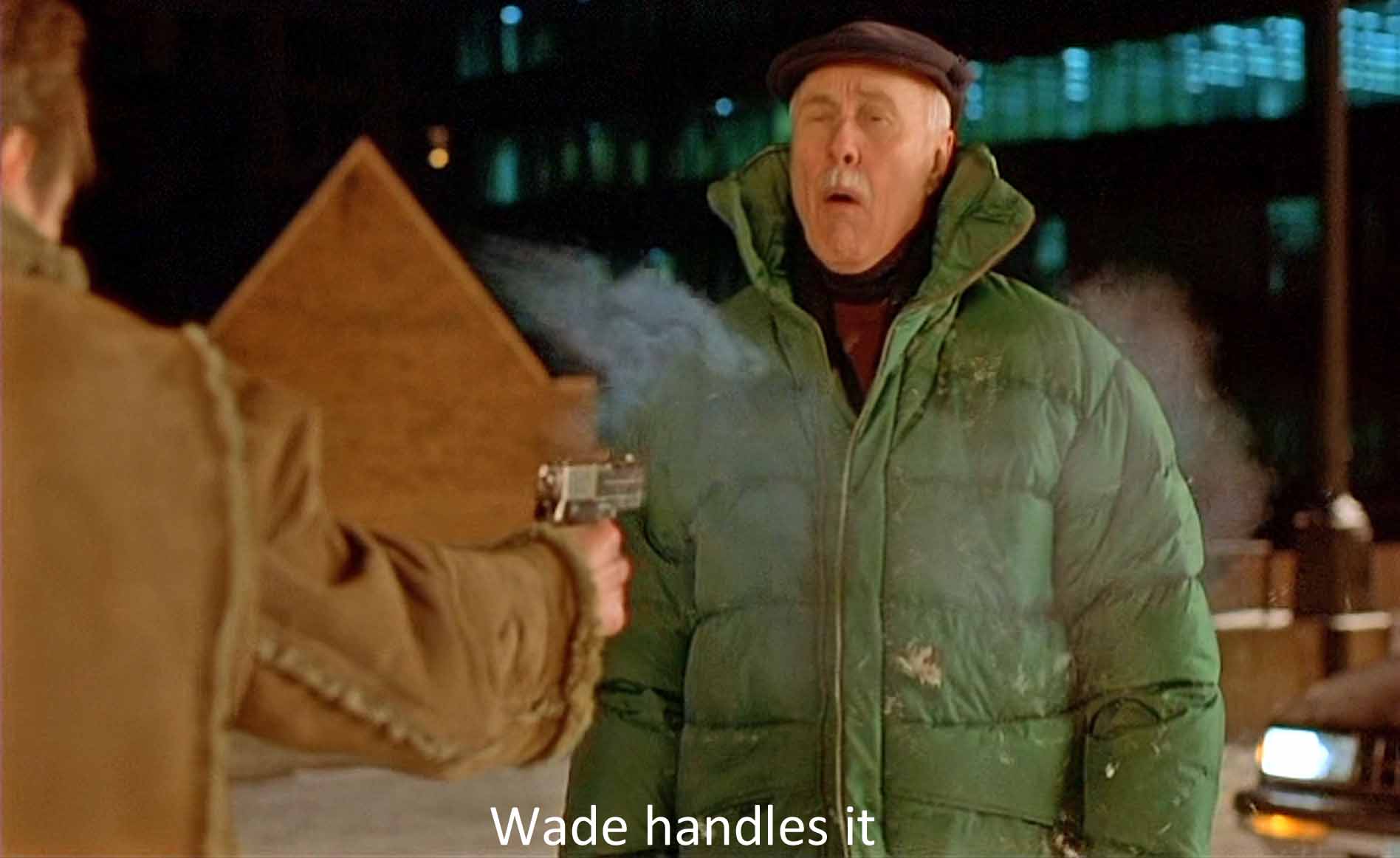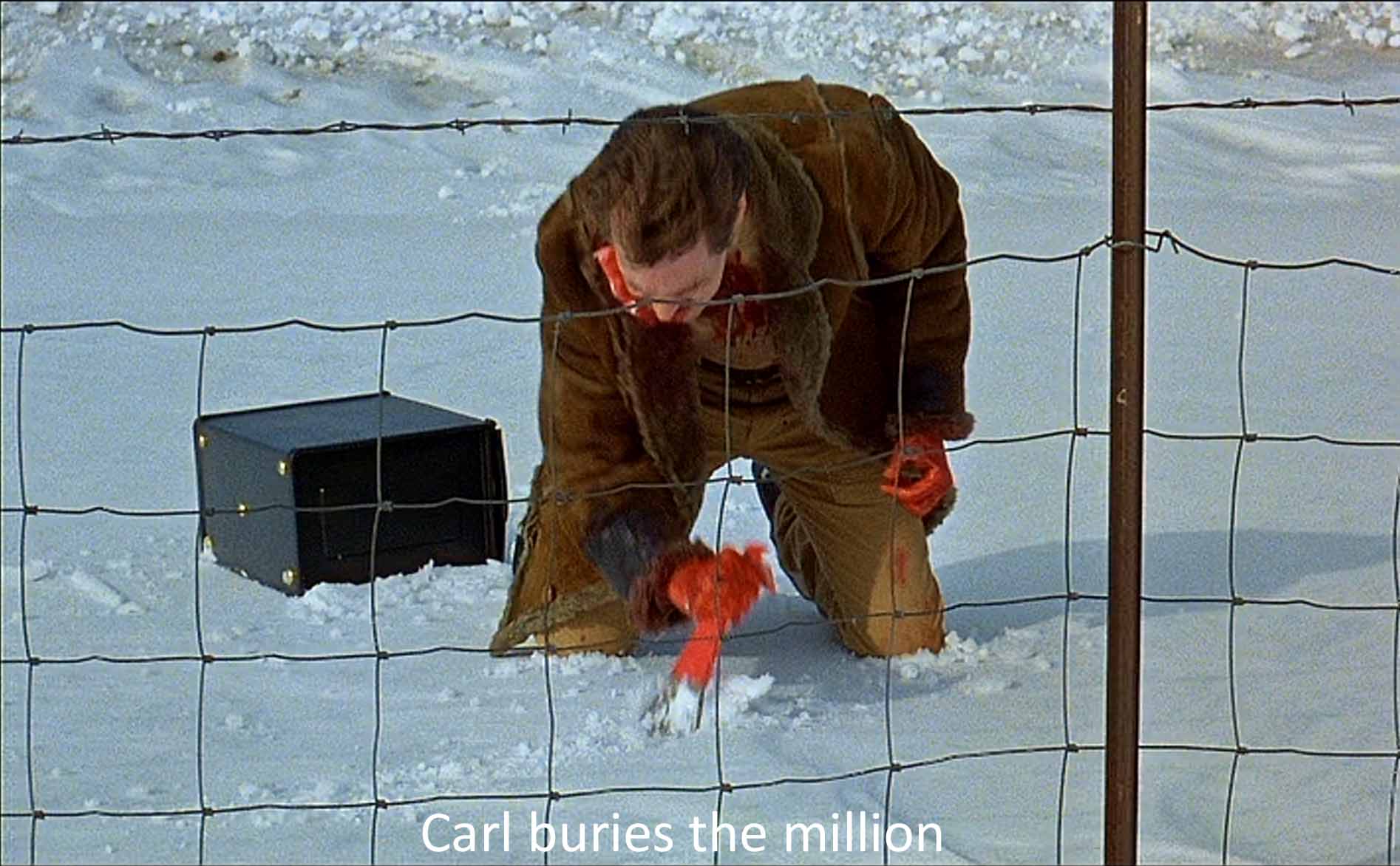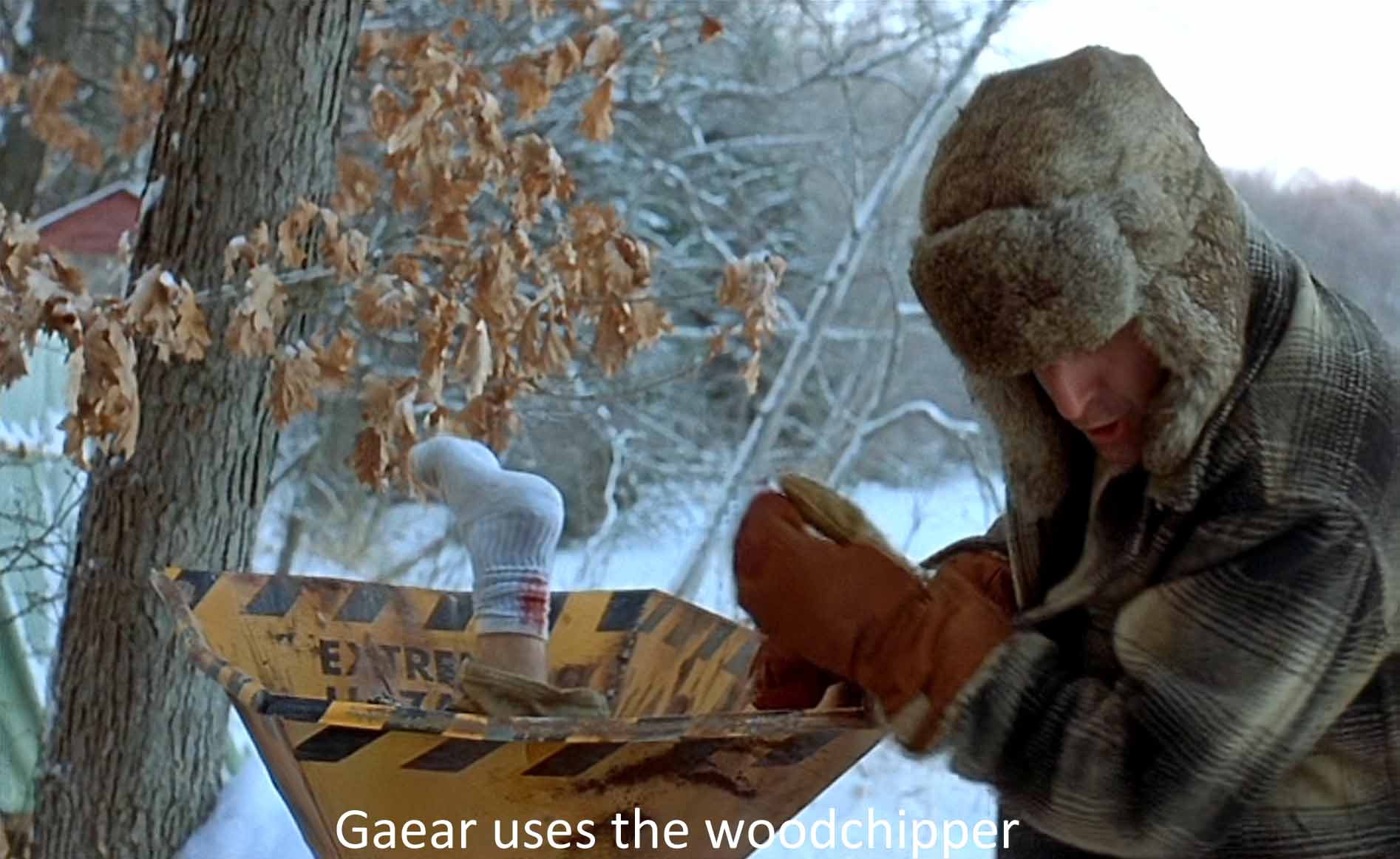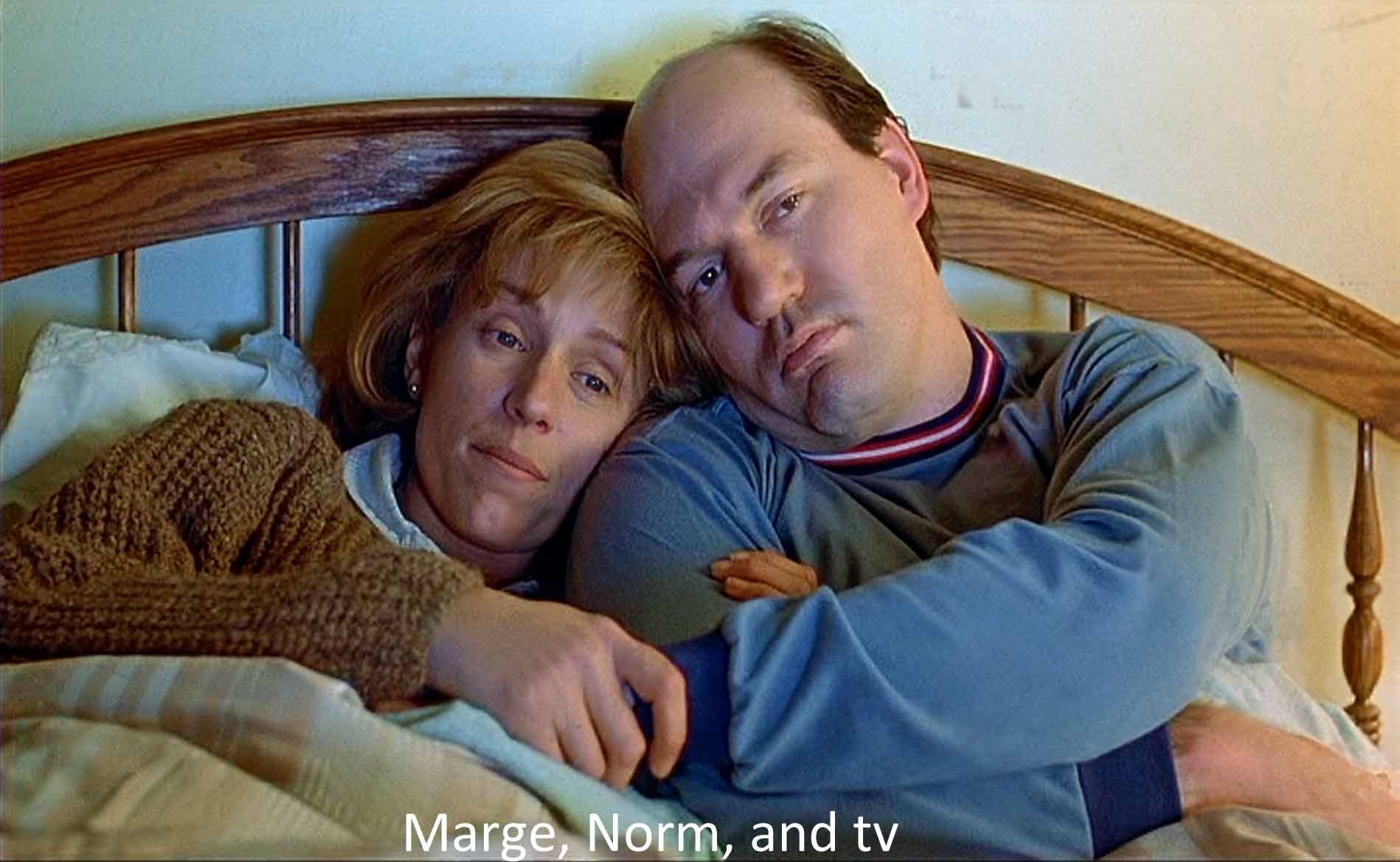Quirky? Of course! This is a Coen brothers film. It opens on a blank blue-gray screen, snow and a gray sky, so like in color that we can scarcely see a horizon line. Shapes gradually form, a road, telephone poles, a car (and cars will be a major image in this film). Again and again, Fargo shows these vast stretches of snowy wasteland with scarcely any line between snow and sky. Cinematographer Roger Deakins combined long and wide-angle lenses to increase the sense of space. And the snow! Alas for the poor Coen brothers—when they were filming, Minnesota had its warmest winter in years and, unbelievably, the Coens had trouble getting snow. They had to manufacture snow or import it from North Dakota or Canada. And this film was shot entirely on location except for the bathroom scene.
That vast, cold, empty wasteland spreads two worlds apart. Minneapolis and Brainerd, Minnesota, an improbable but nevertheless real place. Only one scene takes place in Fargo, North Dakota, on the far side of Brainerd from Minneapolis, yet that is the film’s name. It is the first of many Coenesque duplicities.
Our hero is that favorite Coen character, a jerk with a scheme that goes bad. His name is Jerry Lundegaard (William H. Macy, a delight to watch). He has come to Fargo to hire two thugs to kidnap his wife so that his father-in-law, Wade Gustafson (Harve Presnell) will hand him a million dollars to pay the ransom (and Jerry can then pocket the million). That’s the “deal.” Jerry and Wade are Swedish in origin like most of the Minnesotans. They all speak a wonderful dialect that projects openness and honesty—sure! The film is full of duplicities, starting with the bar where Jerry meets his accomplices. The “King of Clubs” is anything but kingly.
Jerry’s kidnapping scheme is a double double-cross: he plans to get a million from his mean, stingy father-in-law; he plans to give his two thugs just $40,000 of that money.
As for the two thugs, the brains of the outfit, and I hesitate to use the term, is Carl (Steve Buscemi) with his frantic jabber and rubbery face (“funny-lookin’”). His partner, Gaear (Peter Stormare) is a mute, blond beast whose simple answer to any person causing difficulty is kill’em, as he finally does with Carl. And then he finds a use for a woodchipper that I doubt the manufacturer ever dreamed of.
When, despite Jerry’s efforts, Carl gets his hands on the whole amount, he steals $920,000 from Gaear. Then, too, as between Jerry and Wade, the domineering father-in-law steals another deal that Jerry had planned for himself. Wade defeats Jerry’s plan to get his hands on the ransom money and gets himself killed for his pains.
Everybody steals, and in the process Wade’s million dollars simply gets lost. (A Japanese fan killed herself after travelling to America to find it—thus demonstrating the folly of falling for the movies’ crafted illusion that they portray realities, the duplicity of all movies.)
Everything in Minneapolis (and Fargo) is a deal, and the deals are all crooked. When we first see Jerry at work, he is double-crossing a customer at his father-in-law’s GM dealership where Jerry is, he says, “executive sales manager.” He is making the customer, despite the man’s fury, pay for undercoating, the ironically named Tru-Coat, that he didn’t want and didn’t order. It then turns out that Jerry has embezzled from his father-in-law and GMAC, the dealership’s financing agency.
Minneapolis is not a nice place in this movie. It’s usually called “the Twin Cities” as if to point up the duplicity that permeates this side of the movie. Or the “disparity,” a noun Jerry’s wife provides. Minneapolis is a city of “material greed and the rapacious pursuit of self-interest” (according to Jeanne Carriere in a fine essay on this film).
Everything in Minneapolis is a “deal,” but the deals are never square, always crooked (like the Tru-Coat). Jerry describes a deal he needs money for to his father-in-law, and Wade grabs the deal for himself. (That may be good business sense, but lousy family sense.) Jerry needed the money because he has embezzled $320,000 from the car agency. The Twin Cities are one double-dealing after another.
Wade Gustafson’s disappeared million dollars is one duplicity—or joke—from the Coen brothers. So is the title, Fargo. That town only appears in the brief opening scene so that the very title of the movie is a deception. (Did the Coens want us to think of far-go or go-far? They said in an interview that they just liked the sound of “Fargo”.) The brothers themselves take part in the Minneapolitan duplicities. They put another deception in the opening title card that proclaims this is a true story. No. the closing title card makes the usual disclaimer that you shouldn’t think that this film has anything to do with anybody living or dead. And the brothers have now told the press there was no “true story.” They just said that to get us to swallow this improbable tale. That’s another duplicity associated perhaps with Minneapolis, since the brothers grew up in a suburb of that city. There they got a feel for the people and the Minnesota dialect and maybe for their curiously erratic, half-mad film style (more evident in, say Barton Fink [1991] or Raising Arizona [1987] or The Hudsucker Proxy [1994] than Fargo. Fargo is, as Coen films go, relatively realistic).
I find one Minneapolis episode puzzling, at least at first. Our heroine, Jerry’s nemesis, is Marge Gustafson, the seven-months pregnant sheriff of Brainerd (Frances McDormand in a delightful performance). She agrees to meet Mike Yanagita (Steve Park), a classmate (sweetheart? date?) from high school. He calls late at night when she is in bed with her husband, and, for reasons unknown, she agrees to meet him in Minneapolis, a two hours’ drive away, making a perhaps unnecessary trip to do so. She doffs her shapeless down-stuffed chief-of-police garb and gets prettied up. But, when it turns out that he just wants to put the make on her, she backs off—fast. Later she learns that the sob story he tried to tempt her with was a fake. Yanagita’s attempt at seduction and Marge’s short-lived flirtation with infidelity make one more of the Minneapolitans’ duplicities.
Minneapolis is also a place of undiluted male aggressiveness: Mike’s seductive lying, Jerry’s casual attitude toward kidnapping his wife, Wade, his father-in-law’s tyranny, and, of course, the crazy violence and cruelty of the kidnappers. The hardest thing to watch is Carl’s laughing at poor blindfolded Jean Lundergaard’s (Kristin Rudrüd) stumbling and running about—blindman’s buff—in her frantic efforts to escape.
The Coens’ Minneapolis is a bad place of thievery, brutality, and the double-cross. Brainerd, separated from Minneapolis by a wasteland of snow and cold, is a place where people are honest and caring. They protect and nurture one another. The figure who epitomizes the Brainerd ethos is its chief of police, Marge Gunderson.
Oddly (but this is the Coen brothers) the heroine does not appear until 33 minutes into the film. She is seven months pregnant, a likable figure we can associate with fertility, life, and loving--perhaps that’s the reason for the Mike Yanagita episode. Most fictional detectives, starting with Sherlock Holmes, have something wrong with them: drugs, drink, womanizing, misogyny, slovenliness, depression, OCD—you name it. With Marge it's as though June Cleaver took up detecting.
Look at the way Marge handles her dimwitted deputy’s failure to realize that license plates beginning with DLR are dealers’ plates. He’s got the whole state police looking for a car with plates beginning DLR. “I'm not sure that I agree with you 100% on your police work there, Lou.” “Yah?” “Yah.” In Brainerd, we are kind to the mentally challenged.
In the same kindly, intelligent way, Marge comforts her husband Norm (John Carroll Lynch) when his painting of a mallard duck only got second prize with the Post Office. It will appear on the three-cent stamp, while his rivals’ picture will be on the twenty-nine-center.
Norm: People don't much use the three-cent.
Marge: Oh, for Pete's sake, of course they do. Whenever they raise the postage, people need the little stamps.
Norm: Yah?
Marge: When they're stuck with a bunch of the old ones.
Norm: Yah, I guess.
Marge: It's terrific. I'm so proud of you, Norm.
Norm: Yah.
Whenever we see him, Norm seems half-asleep, a man whose life seems to consist of ice-fishing and painting ducks. But he tends Marge just as she tends him, making her breakfast when she’s called out in the middle of the night and jump-starting her car in the icy dawn.
People are kind and good in Brainerd, but OMG!, how dull, boring, and brainless. A New Yorker like me would lose his mind in a week in such a world. (The only non-white people in the film are in Minneapolis.) The emptiness of the language matches the emptiness of the spaces. Technically, linguists call it “Northern cities vowel shift,” while regular people, non-linguists, call it “Minnesota nice.” The Coens had speech coaches to help the actors get it exactly right. Irreverent coastal types like me like to ask Minnesotans to demonstrate it. And it is a major contributor to the blah that is Brainerd. “Yah, you got that right.” “Yah!” That dialect is the one feature of Fargo that people most remember, delight in, and imitate.
The Coens write their scripts jointly and meticulously. When Peter Stormare (Gaear) thought “pancakes house” was a typo and said, “pancake house,” during a shoot, the brothers corrected him. “There are no typos in our scripts.” They delight in dialect and various styles of speech, the lefty rhetoric of Barton Fink, the Southernisms of Oh, Brother, the legalisms of True Grit, and so on.
Brainerd (brain-erred) may seem to be populated by simpletons with overbites who say “Yah” and “Yer darn tootin’” and “You betcha” and other Palinisms all the time. Brainerdians can’t describe Carl except to say he’s “funny-lookin’.” Things are never simple with the Coen brothers, though. Marge is just plain smart, the cleverest person in the film. She deftly solves the three murders that have polluted her town. Moreover, her speech chiding the brute Gaear, whom she has just arrested, is the moral center of the film. She delivers it in a car scene that echoes the opening car scene. She lists the killings: “And for what? For a little bit of money. There's more to life than a little money, you know. . . . And here y'are [arrested, in a police car]. And it's a beautiful day. Well. I just don’t unnerstand it.” She follows this homily with comforting Norm under the big warm quilt—and discussing the three-cent stamp, surely “a little bit of money”—another Coenesque trick.
In that closing scene, the warmest and coziest of the whole movie, they go off to sleep with words of love and mothering as the bark beetle feeds its young on the tv screen. “I love you, Margie.” “I love you, Norm.” (How could I not love a movie that ends with “I love you, Norm”?)
Yes, people are honest and kindly and slow in Brainerd—maybe. At the entrance to the town stands its tutelary deity, a gigantic statue of Paul Bunyan with glaring eyes and hideous grin. He is carrying his axe that echoes the axe Gaear will wield in the last of the seven murders in the film. All is perhaps not as lovey-dovey in Brainerd as the kindness of Marge would suggest. The Coens anchor both corrupt Minneapolis and Brainerd in twentieth-century culture by making cars and television and junk food the dominant images shared by both.
Cars in Fargo are so closely identified with persons that they take over. They become the equivalent of your body or your money. Cars are the equivalent of money in the sale and financing and embezzlement in the GM dealership or the fight over Tru-Coat, when the frustrated customer almost bursts into tears. Jerry’s down payment to the kidnappers is a “burnt umber Ciera.” And they stand for persons. Jerry whacks his own car in his fury at himself for losing out to his father-in-law’s tyranny and greed and his own blundering failure to cope with him. License plates lead to Carl and Gaear’s downfall. The car is the way Marge spots the one remaining bad guy in the hideout. “My car! My car! Tan Ciera. Tan Ciera.” Jerry’s car is the way he is trapped at the end. Cars become substitutes for people.
Television also pervades the movie, soaking into the mind. Everybody watches television. Wade clenches a squeeze ball to bring down his blood pressure as he watches a hockey game. Jerry’s son can’t take his eyes off the tv during breakfast. Jerry’s ditzy wife keeps on watching television (morning television at that!) even as she sees a masked man prowling around her home. The kidnappers have the tv on when they are having their frenetic sex with prostitutes. Gaear cannot stop staring open-mouthed at a soap opera when Jerry reports back with the money due him. He keeps on watching that soap opera even as Carl takes the prized Ciera away from him. If cars link to people, television fuses with minds.
Food: Jerry appears again and again bearing groceries. At the car lot, Jerry’s “boss” eats and takes in television at the same time. We see the troubled dinner at the Lundergaards’, the growling father-in-law and sassy son. A key line for Gaear is “Pancakes hause,” and he and Carl treat food and “getting laid” as on the same level. Norm fixes Marge eggs for breakfast, and later treats her to Arby’s. Then we watch Marge scarf down huge gobbets of food from a cafeteria steam table. She is, after all, eating for two. When people watch television, they watch open-mouthed, and often they are eating. The mouth is the earliest, most primitive of the stages of our infantile development in traditional psychoanalysis. Mouth and eyes have to do with taking in, like television. And they are linked to unrestrained sex and aggression in later life—and in Fargo.
Fargo paints a picture of unrestrained male aggression. All the men are focused on money (even Norm). All the men on the Minneapolis side of things treat women badly, and the women are either feeders (mothers) or hookers. In Brainerd, Marge apparently rules the town, and she and her female employees get treated with respect. She, too, is—or will be—a mother, and she certainly mothers Norm and her bumbling deputy, and even Mike Yanagita. As a psychological critic, I could read the eccentric world of Fargo as a world of psychoanalytic orality, a world like an infant’s, polarized between icy cold and warm coziness, harsh, rival father and warm, comforting mother. Wade dominates in Minneapolis; Marge is dominant in Brainerd.
In more familiar psychoanalytic terms, the downtrodden son (Jerry) confronts a domineering father-figure (Wade), and loses--a standard oedipal plot. Here we have, in effect, three sons: hapless Jerry, crazy Carl, and brute, mute Gaear. All are incompetent in varying ways, but they do succeed in getting two parent-figures (Wade and Jean) killed. But the boys are all defeated by the character opposite to the domineering father, a strong, capable woman, more in touch with the real things of this world than the men are. The men are all chasing money or involved in grotesque schemes and behavior--things that don't ultimately count. Only Marge is solid and wise.
Could we say that the Coens' sense of people being defined by place or by film genre corresponds to a son being defined (or confined) by a father? And that the Coens' quirky style and their strong women burst out of such a confinement? Maybe.
I think the Coen brothers are more psychological than they are given credit for. After all, their capricious style of filmmaking looks unrealistic, sometimes even surreal. But in their recurring style, I think the Coens take a pair of human traits and run with the possibilities of their interaction, often the conflict between them. Here it is the conflict between cleverness and stupidity or between greedy male selfishness and motherly nurturing. In Barton Fink, it’s between power and creativity. In A Serious Man, it’s conscientiousness and fecklessness. In Miller’s Crossing, it’s loyalty and lust for power. In Raising Arizona, it’s crime and repentance. And so on.
The Coens’ movies rest on solid, old-fashioned American values. Here the country folk who look dumb and backward outwit the city slickers—a tactic that goes back to the silent era. And the movie makes greed, lechery, cruelty, and so on, look bad. What’s so challenging here? Well, the whole style of the film that mixes ugly crime with outlandish comedy.
The Coens are surely the most adventurous filmmakers in wide circulation in the U.S. today. They take chances, and they succeed. I love their movies, and evidently millions of other people and the award-givers do, too. The Coens deserve their accolades. Rich, psychologically complex, visually interesting, with exquisitely crafted language and teasing endings—these are great films and great filmmakers.

